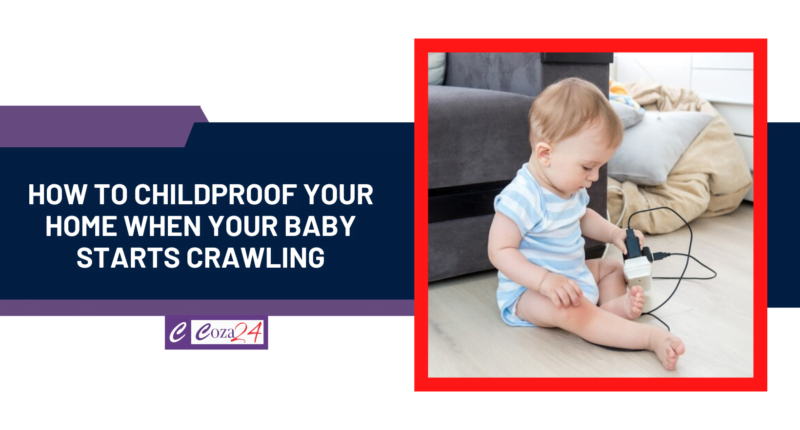Learn “How to childproof your home when your baby starts crawling” Having a baby is one of the most joyous experiences in life. However, with a new little one in the house, it’s important to take measures to ensure their safety and protect them from any potential hazards. Baby proofing your home is an important step in securing the safety of your little one, giving you peace of mind and allowing you to relax and enjoy the time with your new family member. In this guide, we will cover the essential steps to baby proof your home and keep your little one safe and protected.
Table of Contents
- 1 How to childproof your home when your baby starts crawling
- 2 Understanding the Hazards in Your Home
- 3 Use Baby Gates to Block Off Stairs and Hazardous Areas
- 4 Install Outlet Covers
- 5 Secure Furniture to Prevent Tipping
- 6 Remove Small Objects that Could be Choked On
- 7 Keep Dangerous Chemicals Out of Reach
- 8 Cover Sharp Corners on Furniture
- 9 Kitchen Safety
- 10 Bathroom & Laundry Room Safety
- 11 Bedroom & Playroom Safety
- 12 Staircase Safety
- 13 Tips for Making your Home Baby Safe
- 14 FAQs
- 15 Conclusion
How to childproof your home when your baby starts crawling

Understanding the Hazards in Your Home
The first step in baby proofing your home is to understand the potential hazards that exist in your home. Babies are curious and love to explore, so it’s important to be aware of any areas that could pose a danger to them. Common hazards include sharp corners on furniture, electrical outlets, loose rugs, and chemicals or dangerous substances that are easily accessible. It’s important to identify these hazards and take the necessary steps to eliminate them.
Use Baby Gates to Block Off Stairs and Hazardous Areas
One of the most effective ways to keep your baby safe is to use baby gates to block off stairs and other hazardous areas. Baby gates are an affordable and effective way to prevent your little one from accessing areas that could be dangerous. When choosing a baby gate, look for one that is sturdy and can be securely attached to the wall. You should also consider the height of the gate, ensuring it’s tall enough to prevent your baby from climbing over it.
Install Outlet Covers
Another important step in baby proofing your home is to install outlet covers. Babies have a tendency to put things in their mouths, and electrical outlets can be a hazard. Outlet covers are easy to install and are an affordable way to protect your baby from electrical shock. Look for covers that are made from durable materials and have a secure fit to ensure they stay in place.
Secure Furniture to Prevent Tipping
Furniture can also pose a hazard to babies, especially if it’s not secured to the wall. To prevent furniture from tipping over, use furniture straps to secure it to the wall. This will prevent your baby from pulling on furniture and causing it to tip over, potentially causing injury. You can purchase furniture straps at most hardware stores, and they’re easy to install.
Remove Small Objects that Could be Choked On
Babies have a tendency to put everything in their mouths, so it’s important to remove small objects that could be choked on. This includes toys, coins, and other small items that could pose a choking hazard. Keep your home free of these items and ensure your little one has access to age-appropriate toys that are safe for them to play with.
Keep Dangerous Chemicals Out of Reach
Dangerous chemicals, such as cleaning supplies and medications, should be kept out of reach of your baby. Store these items in a locked cabinet or high up on a shelf that your baby cannot access. If you use these chemicals frequently, be sure to keep them out of reach when you’re not using them.
Cover Sharp Corners on Furniture
Sharp corners on furniture can also pose a hazard to babies. Cover these corners with corner protectors to prevent your baby from bumping into them and causing injury. Corner protectors are easy to install and are an affordable way to protect your little one.
Kitchen Safety
When your baby starts crawling, it’s time to start baby-proofing your home. Here are some tips for keeping your little one safe in the kitchen:
1. Keep dangerous items out of reach. Store knives, cleaning supplies, and other potentially hazardous materials in a safe place where your baby can’t get to them.
2. Keep an eye on your child at all times. Never leave your baby unattended in the kitchen, even for a moment.
3. child-proofing products can help keep your baby safe. Install cabinet locks to keep curious fingers away from dangerous items, and use safety covers on outlets to prevent electrocution.
4. Teach your child about kitchen safety. As they get older, teach them about the dangers of certain items and how to use them safely.
You may also be interested in: New record: Cristiano Ronaldo scores his 500th league goal
Bathroom & Laundry Room Safety
Bathroom and laundry room safety is essential for any home with a crawling baby. Here are some tips to help you keep your little one safe in these rooms:
• Keep all cleaning products and medicines out of reach, preferably in a locked cabinet.
• Never leave your baby unattended in the bathroom, even for a moment.
• Keep the toilet lid down at all times to prevent accidental drowning.
• Install child-proof locks on all cabinets and drawers containing potentially hazardous items.
• Always test the water temperature before bathing your baby to avoid scalding.
• Keep laundry detergent and other chemicals well out of reach.
Bedroom & Playroom Safety
As your baby starts to become more mobile, it’s important to take extra care to ensure their safety in your home. Here are some tips for making your bedroom and playroom safe for your little one:
• Remove any loose items from the floor that your baby could trip over or pull down on top of themselves.
• Secure any furniture to the wall using brackets or straps to prevent tipping.
• Place soft pads or rugs around the room to protect against bumps and bruises.
• Keep all sharp objects and choking hazards well out of reach.
• Use Gates or Door Stops to keep baby from accessing areas you don’t want them in.
Staircase Safety
Staircase safety is one of the most important aspects of baby-proofing your home. When your baby starts to crawl, they will be able to explore every nook and cranny of your home, including the staircase.
There are a few things you can do to make sure your staircase is safe for your little one:
1. Install a baby gate at the top and bottom of the staircase. This will prevent your baby from being able to access the stairs without supervision.
2. Keep any cords or wires away from the staircase. Babies are curious and may try to pull on cords or wires, which could cause them to trip and fall down the stairs.
3. Make sure there are no loose tiles or carpeting on the stairs. Loose tiles or carpeting can cause babies to trip and fall, so it’s important to secure them before your baby starts crawling around.
4. Keep stairways clear of toys and other objects. Babies may try to grab onto anything they can reach, which could cause them to lose their balance and fall down the stairs.
5. Always hold your baby’s hand when going up or down stairs. This will help keep them safe and prevent them from falling.
Tips for Making your Home Baby Safe
As your baby starts to become more mobile, it’s important to make sure your home is safe for them. Here are some tips for making your home baby safe:
- Remove any potential hazards from the ground level. This includes things like cords, small objects, and sharp edges.
- Install childproof locks on all doors and cabinets.
- Cover electrical outlets with childproof covers.
- Use safety gates to block off stairs and other dangerous areas.
By taking these precautions, you can help create a safe environment for your crawling baby.
FAQs
1. When should I start baby-proofing my home?
It’s a good idea to start thinking about baby-proofing your home as soon as your little one starts showing interest in exploring their surroundings. This is usually around the time when they start crawling or pulling themselves up to standing.
2. What are some common hazards I need to look out for?
There are many potential hazards in any home, but some of the most common ones to watch out for are sharp corners, loose cords and electrical outlets, small objects that could be swallowed, and poisonous household chemicals.
3. How can I make my home safer for my crawling baby?
There are a number of ways you can make your home safer for your crawling baby. Some simple measures include installing corner guards on sharp furniture edges, tucking away loose cords and removing small objects from reach. You can also child-proof electrical outlets with covers and keep dangerous household chemicals locked away in a safe place.
Conclusion
Preparing your home for when your baby learns to crawl is an important step in creating a safe, secure environment for them. By following the tips outlined above, you can help ensure that your home is properly baby-proofed and ready for their new milestone. Taking the time to make sure everything is set up correctly will create peace of mind and provide a safer space where both you and your little one can feel comfortable.
See Also:
Continue to check our website for more articles of this kind. And, please use our comment section as well, we would love to hear from you.









